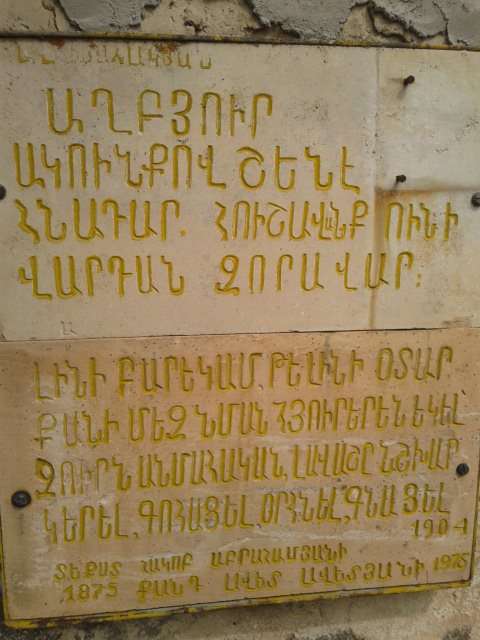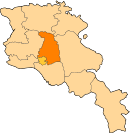Alapars
| Alapars Ալափարս | |
|---|---|
|
The church of Vardanavank built in 901, reconstructed in the 19th century | |
 Alapars Ալափարս | |
| Coordinates: 40°25′17″N 44°38′05″E / 40.42139°N 44.63472°ECoordinates: 40°25′17″N 44°38′05″E / 40.42139°N 44.63472°E | |
| Country | Armenia |
| Province | Kotayk |
| Founded | 470, resettled in 1828-30 |
| Government | |
| • Mayor | village Head |
| Area | |
| • Total | 32.94 km2 (12.72 sq mi) |
| Elevation | 1,500-1,601 m (−3,753 ft) |
| Population (2008) | |
| • Total | 2,538 |
| • Density | 77/km2 (200/sq mi) |
| Time zone | UTC+4 (UTS +4) |
| Area code(s) | +374 (226) |
Alapars (Armenian: Ալափարս; formerly known as Aylaberk, Aylaber) is a village in the Kotayk Province of Armenia. The village has 860 dwellings, a school, house of culture, and library. The population is entirely Armenian. Notable natives are director of pump station of the Alapars, USSR multiple medalist Avetik Avetyan, Patriarch Mushegh Aliabertsi (490-561), artist Tatik Saryan, dramatist Melik Kocharyan, folk collector Shavigh Grigoryan, The statesman of RA, Governor of Kotayk Republic of Armenia Kavalenko Shahgaldyan.
Alapars was founded in 470, but was resettled in 1828-30 by immigrants from Khoy and Maku. Its center is dominated by the churches of Saint Vartan (Vartanavank) built in 901 (rebuilt 19th century) by a Prince Grigor, and the Holy Mother of God (Surb Astvatsatsin) of 1897. Also in the vicinity is the monastery of S. Tsiranavor. According to local folklore, Vartanavank contains a drop of blood from the Armenian national hero Vartan Mamikonian.[1][2]
Gallery
- S. Astvatsatsin Church (Holy Mother of God Church), 1897
- Large khachkar adjacent to Vartanavank

See also
References
- ↑ "Alapars (Kotayk)". CAA: Union of Communities of Armenia. Archived from the original on June 22, 2015. Retrieved May 30, 2015.
- ↑ Kiesling, Brady; Kojian, Raffi (2005). Rediscovering Armenia: Guide (2nd ed.). Yerevan: Matit Graphic Design Studio. p. 95. ISBN 99941-0-121-8.
- Alapars at GEOnet Names Server
- World Gazetteer: Armenia – World-Gazetteer.com
- Report of the results of the 2001 Armenian Census, National Statistical Service of the Republic of Armenia
- Kiesling, Brady (2005), Rediscovering Armenia: Guide, Yerevan, Armenia: Matit Graphic Design Studio
- Brady Kiesling, Rediscovering Armenia, p. 57; original archived at Archive.org, and current version online on Armeniapedia.org.
External links
| Wikimedia Commons has media related to Alapars. |
